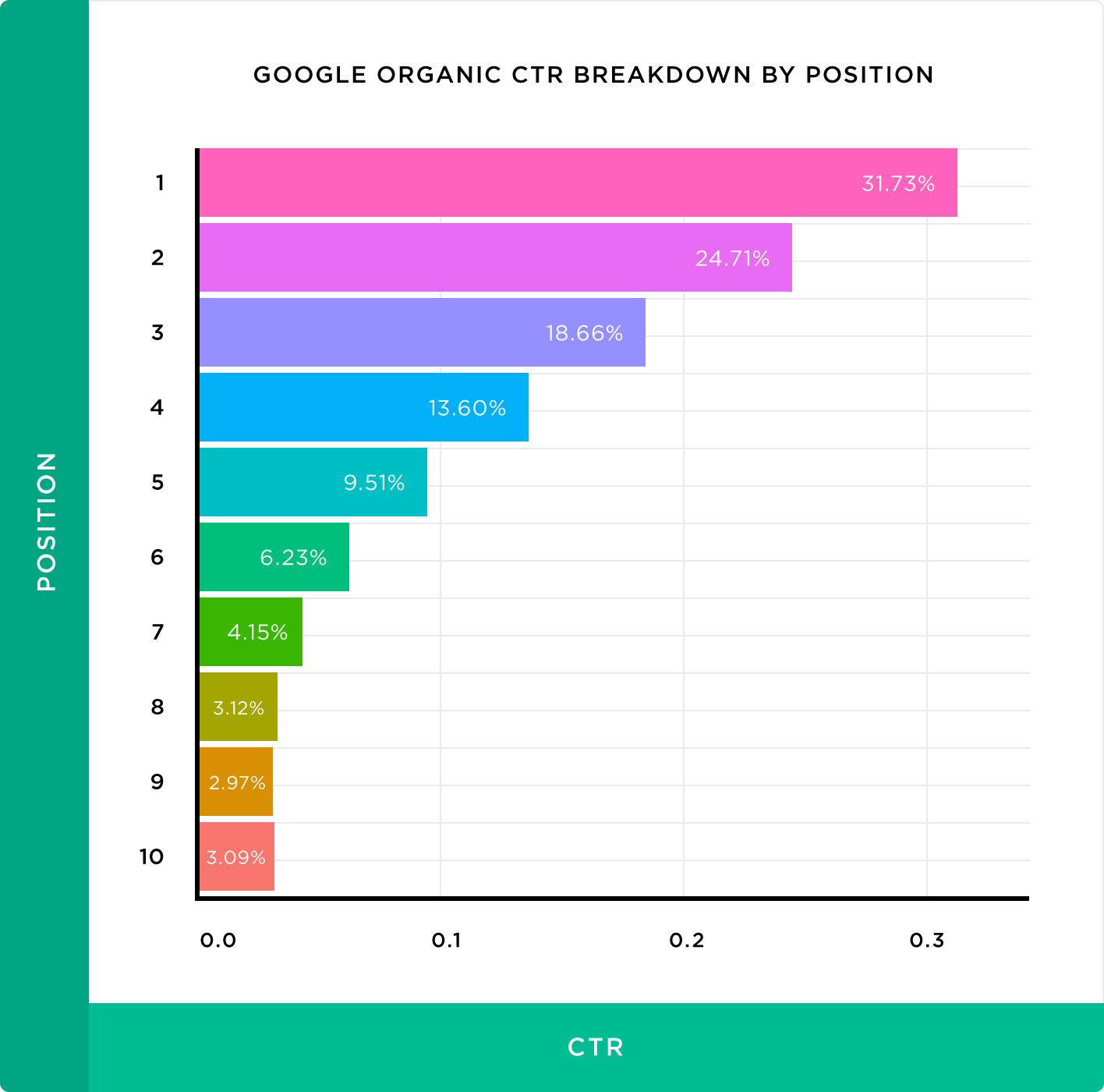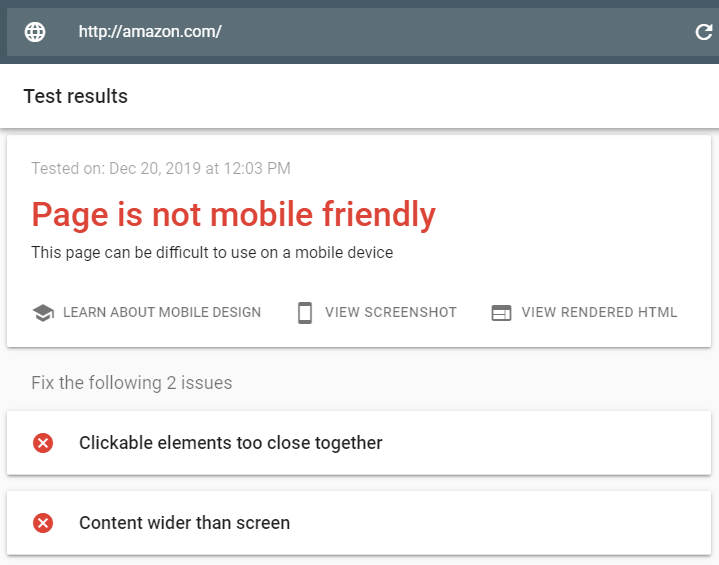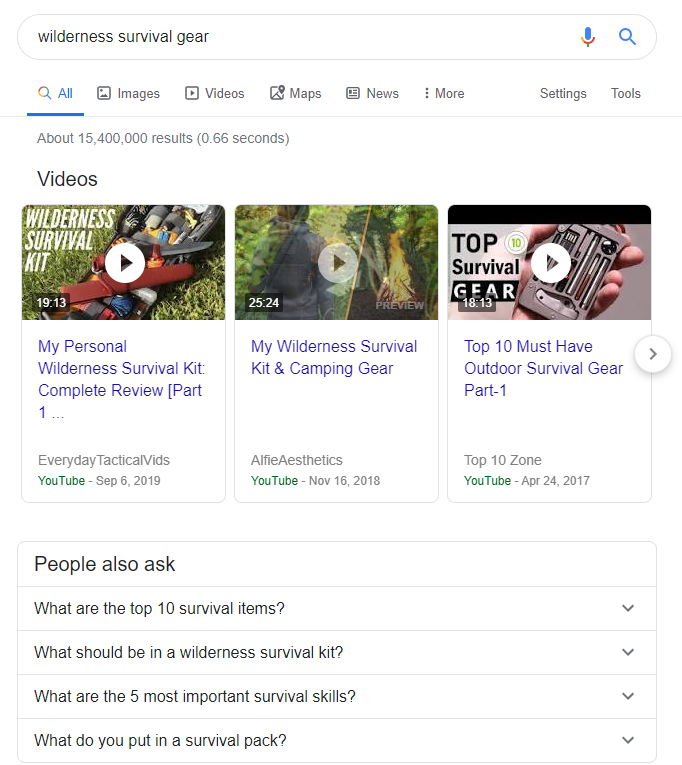Google employees often say that search is much simpler than we make it out to be. And it’s a very tempting statement, but we have to remember that, allegedly, there are over 200 SEO ranking factors used in Google algorithm. That’s far from simple.
Still, Google is getting better at understanding our content and interpreting our search goals, which does indeed make some of our work simpler. To that end, I believe that in 2020 we will see a further departure from making algorithm-centric content and a growing emphasis on technical SEO. So, here is my take on the key ranking factors in the upcoming year.
1. Search intent
Search intent is one of the more recent SEO ranking factors. It’s all about trying to match the type of content users expect to the wording they use in their queries. In practical terms, accounting for search intent means that whenever you want to rank higher for a certain keyword, you google it, look through top-ranking pages, and create a similar type of content for this keyword. Basically, instead of relying on your own interpretation of keywords, you are using search results to help you make a connection between the keywords and the type of content your users want to see.
For example, a query like “types of winter jackets” has informational intent and top-ranking results are guides on different jacket features. But a query like “best winter jackets” is meant for commercial investigation and top-ranking results are mostly listicles of specific jacket models. While the keywords are somewhat similar, the intents are quite different, and you are unlikely to rank with a listicle for a query that demands a guide and vice versa.
2. Appealing snippets
It’s perhaps a little naive to say that success in Google rankings is about writing the most appealing title, but it’s something we shouldn’t neglect even today. And one way to see whether your title is performing adequately is by looking at CTR benchmarks.

Image source: Backlinko
If any of your top 10 results are getting fewer clicks than they are supposed to, then you are at risk of losing your position. To avoid that, you have to experiment with your title and meta description, use a descriptive, human-readable URL, and apply schema markup to make your content eligible for rich snippets.
3. Keywords
While keywords remain important in SEO, the way we use them is becoming increasingly less obvious and less aggressive. Neural matching, RankBrain, and recently BERT, are all aimed at extracting meaning from context rather than specific combinations of words, which makes keyword density and exact matches less important for on-page SEO. However, title keywords are still on the list of page-level factors, as are the ones in the headers, alt texts, and main text. But use them sparsely and maintain the integrity of your content—no keyword stuffing or Google will penalize your page. Check out this keyword research guide for more information on best keyword practices
4. Backlink diversity
The number of external pages linking back to your site is still among the most important Google ranking factors. However, lots of links coming from a single source do not carry much value, which is why you have to maintain an extensive network of collaborators and information partners to work on projects that will attract links.
A good way to start building this network would be by spying on your competitors and discovering their backlink sources. Some of their partners might be exclusive to them, but the absolute majority is likely to be business directories, bloggers, and industry publications, that are open to everyone. Acquiring and using this intelligence is one of the lowest hanging fruits in off-page SEO.
5. Backlink authority
Having a lot of links coming from diverse sources won’t help you if those sources are of poor quality, like spammy websites and PBNs. In fact, if any of your pages start getting a lot of low-quality backlinks, Google will penalize that page and, by extent, other pages that it links to.
This could be a great opportunity for your competitors to knock you down a notch by buying spammy links to your website. Which is why you should be auditing your backlinks on a regular basis and disavowing the ones that come from low authority sources. A tool just for that is SEO SpyGlass—it generates a full backlink profile for any given domain, complete with link authority, anchor texts, penalty risks, and dozens of other backlink factors.
6. Link anchor text
As semantic search is growing smarter, anchor keywords are becoming less of a backlink factor, though still remain influential. The current rule is to give your anchors a natural-sounding text, include your keywords, but avoid keyword stuffing. Some variance is also good—try not to use the same exact anchor on all of your backlinks, and never use the same anchor for linking to different pages.
7. Internal links
A part of how Google determines the importance of your pages is by the number of internal links that they get and the context of those links. To maximize the effect of this ranking factor, maintain a shallow site structure, audit your site for broken links, use keywords in the anchor text, and create additional opportunities for interlinking your pages. Keep in mind that authority is as important for internal links as it is for external ones, so if you want to give some page a boost—link to it from high authority pages within your website.
8. Mobile-first pages
Even though mobile-first indexing has been around for a while, it’s still common to encounter websites or parts of websites that are not optimized for mobile view. Those websites are at a great disadvantage in terms of user experience and, consequently, Google rankings. If you are one of those websites, then you should definitely move mobile optimization to the very top of your SEO list.

The best practice for mobile optimization is responsive design. It requires the fewest changes to your website by making your current content respond to different screen sizes. The way you implement responsive design depends on the way your site is built. For a WordPress site, it could be as simple as installing a responsive theme, but for a custom-built site, you’d have to make adjustments by hand.
When you have implemented basic responsive features, you can go even further by applying mobile-specific UX. Think simple site structures, touch interactions, bold visuals, super light pages, and elimination of all distractions. Once you feel confident that your website is mobile-friendly, you can test it using Google’s Mobile-Friendly Test or a more comprehensive WebSite Auditor.
9. Fast pages
According to Google, the median load time for a mobile page is 15 seconds, which is in stark contrast to what users expect—53% of them will leave a mobile page that takes over three seconds to load. This is why page speed has been a mobile ranking factor for the past two years and is likely to stay with us for the foreseeable future.
The fact that the majority of mobile pages remain slow is actually good news. It means there is this huge competitive advantage that’s yours if you want it. And if you do, then there are over 20 mobile speed factors to take into consideration, with image size, page redirects, and bloated code leading the pack.
There is also an option to optimize your mobile website using AMP, which promises to load your pages in one second or less. Now I know that AMP is widely criticized for imposing strict design limits (among other things), but it’s actually gotten a lot more flexible recently and allows for even the most advanced of pages. I’d say that AMP is a fair choice for those who’d rather apply a standardized solution than try to hand-tune their website.
10. Featured snippets
Featured snippets are now so common that they’ve become an integral part of SERP. And not just any part, but often the most prominent one, completely dominating over organic search results. The only problem is that you can’t exactly work your way into featured snippets. All you can do is make your content snippet-ready, and, if Google deems it worthy, it might eventually get featured.

Some of the featured snippets that are possible to get into are questions, image pack, local pack, and reviews. The last three are easy: optimize images for the image pack, fill out your Google My Business profile for the local pack, and apply schema markup to review pages.
To get into the question snippet, however, you’d have to be ranked in the top 10 results as it is, and then edit your content into a snippet-ready format. That means articles with query-like headers of about six words (H2/H3), followed by concise, informative answer paragraphs of about 60 words. Try to stick to why and how questions and avoid writing about something that is already answered by Wikipedia/Investopedia—Google is using information partners to fill out factual snippets (dates, names, definitions) and you can’t really compete for these queries.
11. Image optimization
Optimized images are not hugely important by themselves, but they do feed into a number of other site-level factors. Compressing images makes for lighter pages, giving you a boost in page speed. Describing images with proper file names, captions, and alt texts may help them rank in Google Images, and, consequently, make them eligible for visual search queries via Google Lens. And there is also a chance that Google favors content that has visual aids, deeming it a more thorough piece of information. Either way, image optimization is one of those things that we tend to postpone, so perhaps it’s time to finally get it done in 2020.
12. HTTPS sites
An SSL certificate is that thing that changes your address from HTTP to HTTPS and displays a padlock icon next to your domain name. Its primary goal is to show your visitors that the website can be trusted and to hold you accountable in case you mishandle any of your visitors’ personal data.
More importantly, an HTTPS is a ranking signal, and those websites that are not secured may get penalized in search results. So it’s essential that you get a certificate for your website, especially if you handle online transactions or collect any kind of personal data.
13. E-A-T factors
This past year was spent debating whether Expertise, Authority, and Trustworthiness (E-A-T) is one of Google ranking factors. On one hand, there is much talk about E-A-T in Google quality rating guidelines, and there is also some evidence of E-A-T factors affecting ranking. On the other hand, said evidence seems anecdotal, supported by assumptions rather than experiments and statistics. Also, as John Muller has explained in a recent hangout, all quality raters do is double-check the quality of search results—they do not influence the rankings directly.
It’s also worth noting that E-A-T is not an isolated variable, it’s more of a blanket term that covers a number of variables from different areas. Some of those variables, like PageRank, HTTPS, and thin content have been a part of the algorithm for a long time. But other E-A-T variables, like author expertise, are strictly speculative and have never been confirmed.
Nevertheless, optimizing content for those speculative variables takes so little effort, that I would still advise doing it, just in case they become a part of the algorithm in the future. All you have to do is create profile pages for your authors (and make them out to be experts too), always reference your sources, have an “About” page for your company, put up your Terms & Conditions and a return policy (if you are an e-commerce company), and have a detailed contact page. Actually, all of those are a good idea regardless of whether you are trying to please Google, so it’s not a total waste of time even if E-A-T never becomes a ranking factor.
Final thoughts
There is hardly anything on this list that wasn’t there last year, so it’s mostly about reinforcing your current SEO efforts. If I were to pinpoint the areas with the most potential, I’d say that checking your pages against search intent, enhancing page speed, and improving content quality would give you the biggest ranking boost in 2020.
Digital & Social Articles on Business 2 Community
(40)
Report Post






